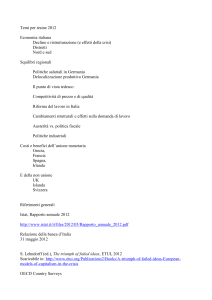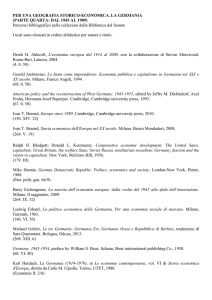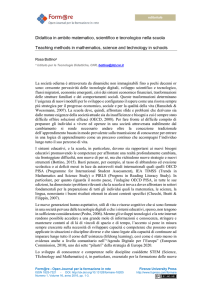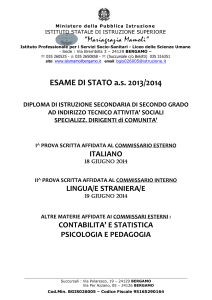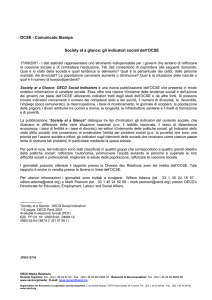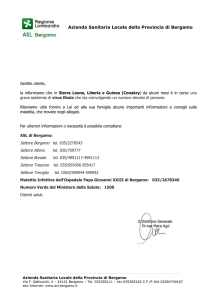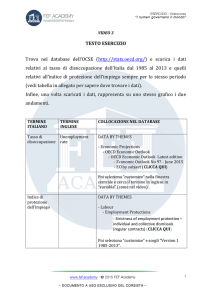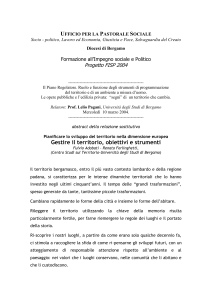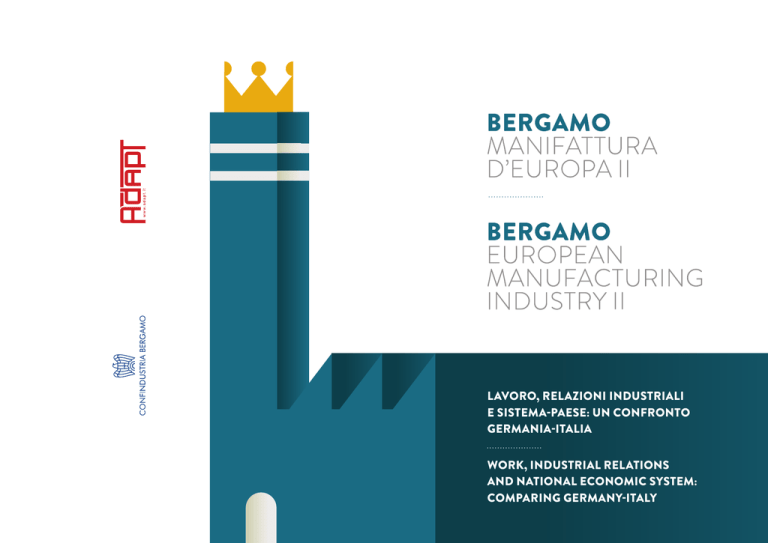
II
II
LAVORO, RELAZIONI INDUSTRIALI
E SISTEMA-PAESE: UN CONFRONTO
GERMANIA-ITALIA
WORK, INDUSTRIAL RELATIONS
AND NATIONAL ECONOMIC SYSTEM:
COMPARING GERMANY-ITALY
Bergamo Europe’s factory proposes a comparative analysis
of Italian and German entrepreneurial systems, specifically
referring to the work organisation and management modes and
investigating the role which the external context has in terms
of industrial competitiveness.
Seven companies with productive units in Bergamo and Germany were involved in the investigation; German manufacturing system is considered the benchmark which inspires development support and which Bergamo’s industries work with and
compete against.
The differences are due to:
• standards, that, over the past years have become progressively more aligned;
• different managerial and organisation approaches, cultural factors, operational practices, the industrial relations
model;
• factors which are external which penalize Italian companies.
Individual elements that determine the current competitiveness differential were identified in order to better understand
the features of the gap between Italian companies and those
operating in Germany, where industries can count on:
• greater flexibility in the management of work times,
• less tax on company and employee income,
• school education integrated with work experience,
• a low level of trade union conflict,
• quick and, above all, reliable relations with public administration.
In any case, some Italian legislation issued over the past twoyear period (if the interventions on work and tax should become structural) seems to identify a progression already traced
by the German model:
1. The Jobs Act and its implementation decrees seem to have
allowed Italian companies to acquire significant environments of managerial dynamicity. These improvements, if
not annulled by first- or second-level restrictive collective
contracting, now allow for organisational solutions in the
management of duties, increases/decreases of work quantity, work times, which may align themselves considerably
to those realisable in Germany.
2. The excessive incidence of the tax wedge - characterising
both the Italian and German system - is to a certain extent
remedied by tax cuts, incentivisation and funding provided
for by the “Garanzia Giovani” programme.
3. La “Buona Scuola” seems to have set up a route which
could align national education with the German dual system. With the introduction of obligatory traineeships (400
hours for the last three-year period of education in technical-professional institutes and 200 for lyceums), a partial
process alternating school and work has become structural,
while before it was realisable only via experimental formulas. The reform favours increasing laboratory and interdisciplinary activities, investments to support teaching IT and
foreign languages, promoting territorial didactic initiatives
to adapt education to the needs of individual contexts.
Finally, it improves the trainee’s discipline and allows for
achieving a high school diploma and a technical specialisation certificate.
While in the education-training-work industry there has been
an alignment in terms of legislation, there are no improvements
in terms of the cost of the national economic system.
The competitive gap, caused by inefficiency and the ever
“missed” simplifications, continues to stop investments and
employment, not only compared to Germany but most of the
big industrial countries.
Each of the ten sheets which make up the file:
• illustrates the (negative or positive) positioning of the Italian productive units compared to those located in Germany and the OECD average;
• suggests several actions intended to reduce the deficit between the organisation of work of German companies and
that which still distinguishes many Italian companies, also in
Bergamo;
• proposes several interventions which may be realized at a
company level in order to allow for greater operational and
managerial flexibility acknowledged and/or increased by
recent standards;
• researches a virtuous approach which overcomes cultural
resistance and puts into effect, at a company level, operational flexibility, the variability of the cost of labour, the
adequacy of the training interventions;
• finaly the cost of deficit in national economic system is
valued.
MATTEO ZANETTI
Confindustria Bergamo
Vice Chairman of
Trade Union Relations
Bergamo Manifattura d’Europa propone un’analisi comparata
dei sistemi imprenditoriali italiano e tedesco, specificamente
riferita alle modalità di organizzazione e gestione del lavoro con
approfondimenti sul ruolo che il contesto esterno esercita sulla
competitività delle industrie.
Nell’indagine sono state coinvolte sette imprese (tedesche o
italiane) con unità produttive a Bergamo e in Germania, il cui
il sistema manifatturiero è ritenuto il benchmark cui ispirare
le politiche di sviluppo e con il quale le industrie bergamasche
lavorano e competono.
Le differenze sono imputabili:
• alle norme che, peraltro, negli ultimi anni sono diventate
progressivamente meno distanti;
• a diversità di approccio gestionale e organizzativo, a fattori
culturali, a prassi operative, al modello di relazioni industriali;
• a fattori esterni che penalizzano le imprese italiane.
Sono stati identificati i singoli elementi che determinano l’attuale differenziale di competitività per cercare di comprendere
meglio le connotazioni del divario tra le imprese italiane e quelle
operanti in Germania, dove le industrie possono contare su:
• una maggiore flessibilità di fatto nella gestione dei tempi di
lavoro,
• un minor carico fiscale sul reddito d’impresa e sul lavoro
dipendente,
• percorsi di istruzione scolastica integrati alle esperienze di
lavoro,
• un basso livello di conflittualità sindacale,
• tempi rapidi e soprattutto certi nei rapporti con la pubblica
amministrazione.
Tuttavia alcuni orientamenti del quadro legislativo italiano emersi
nell’ultimo biennio, qualora diventassero strutturali, indicano una
progressione lungo tre direttici già tracciate dal modello tedesco.
1. Il Jobs Act ed i suoi decreti attuativi sembrano avere consentito alle imprese italiane l’acquisizione di significativi ambiti di dinamicità gestionale. Tali migliorie, se non inficiate da
una contrattazione collettiva restrittiva, di primo o secondo
livello, permettono ora soluzioni organizzative nella gestione
delle mansioni, degli incrementi/diminuzione della quantità
e dei tempi di lavoro, che possono avvicinarsi considerevolmente a quelle realizzabili in Germania.
2. L’eccessiva incidenza del cuneo fiscale/contributivo - propria
sia dell’Italia che del sistema tedesco - risulta in certa misura
ovviata da formule di sgravio, incentivazione e dai finanziamenti previsti dal programma Garanzia Giovani.
3. La “Buona Scuola” sembra aver avviato un percorso che
potrebbe avvicinare il percorso di studio italiano al sistema duale tedesco. Con l’introduzione dei tirocini formativi
obbligatori (400 ore per l’ultimo triennio di istruzione negli
istituti tecnico-professionali e di 200 ore per i licei) si rende
strutturale un parziale processo di alternanza scuola-lavoro,
prima realizzabile solo con formule sperimentali. La riforma
favorisce l’incremento delle attività di laboratorio e interdisciplinari, gli investimenti per supportare l’insegnamento
informatico e delle lingue straniere, la promozione di iniziative didattiche territoriali per adattare l’istruzione alle esigenze
dei singoli contesti. Infine si migliora la disciplina dell’apprendistato con la possibilità di conseguire il diploma di istruzione
secondaria superiore e del certificato di specializzazione
tecnica superiore.
Se nella filiera istruzione-formazione-lavoro si può constatare
un avvicinamento delle legislazioni, non si registrano miglioramenti sul versante del costo del sistema-paese. Il divario
competitivo, causato dall’inefficienza e dalle sempre “mancate”
semplificazioni, continua a frenare investimenti e occupazione,
non solo nel confronto con la Germania ma rispetto alla maggioranza dei grandi Paesi industriali.
In ognuna delle dieci schede che compongono il fascicolo:
• è illustrato il posizionamento (negativo o positivo) delle unità
produttive italiane rispetto a quelle situate in Germania e alla
media OECD;
• si suggeriscono alcune azioni atte a ridurre il deficit riscontrabile tra l’organizzazione del lavoro delle imprese tedesche
e quella che contraddistingue ancora molte imprese italiane,
anche a Bergamo;
• si propongono alcuni interventi che è possibile realizzare a
livello aziendale per conseguire maggiori flessibilità operative e gestionali riconosciute e/o incrementate dalle recenti
norme;
• si ricerca un approccio virtuoso che superi le resistenze culturali e concretizzi, a livello aziendale, la flessibilità operativa,
la variabilità del costo del lavoro, l’adeguatezza degli interventi formativi;
• infine si stima il costo dei deficit del sistema-paese.
MATTEO ZANETTI
Confindustria Bergamo
Vice Presidente ai
Rapporti Sindacali
Contributors to the study companies: ABB Spa, BSCCB Brembo SGL Carbon
Ceramic Brakes, Gapi Group, IMS Deltamatic Spa, Novem Car Interior
Design Spa, Same Deutz-Fahr Spa, Sematic Spa.
Hanno contribuito allo studio le società: ABB Spa, BSCCB Brembo SGL
Carbon Ceramic Brakes, Gapi Group, IMS Deltamatic Spa, Novem Car
Interior Design Spa, Same Deutz-Fahr Spa, Sematic Spa.
The complete research report is available on the Confindustria Bergamo
website (www.confindustriabergamo.it/nri/ricerca2015), integrated by two
contributions by Stefano Franchi, Director-General of Federmeccanica, and
Michele Tiraboschi, University of Modena and Reggio Emilia.
Il rapporto di ricerca completo è disponibile sul sito di Confindustria Bergamo
(www.confindustriabergamo.it/nri/ricerca2015), integrato da due contributi
di Stefano Franchi, Direttore Generale di Federmeccanica, e di Michele
Tiraboschi, Università di Modena e Reggio Emilia.
51.300€
42.100€
38.800€
01
2015
GDP PER HOUR WORKED
PIL PER ORA LAVORATA
PRODUCTIVITY AND COMPETITIVENESS
PRODUTTIVITÀ E COMPETITIVITÀ
From 2000 to 2015, German productivity per hour worked increased
more than 30%; in Italy it remained
substantially stationary.
It even decreased for three years and
then recovered afterwards. After the
economic crisis it was juts over half
of that of the OECD. The partial
recovery is misleading because it was
determined not by the expansion of
production and turnover but, essentially, by the reduction of employment
or by resorting to the fund for workers who are temporarily dismissed.
This particular - negative - evolution
explains the increase of the GDP per
hour worked.
German salaries, over a fifteen-year
period, increased by 10%, while in
Italy - due to indexing and contractual
mechanisms - they have grown 40%.
Basically, sales payments and income
moved on diverging lines; the conse-
Dal 2000 al 2015, in Germania, la
produttività per ora lavorata è aumentata di oltre il 30%; in Italia è rimasta
sostanzialmente stazionaria, per tre
anni è addirittura discesa per poi recuperare nel periodo successivo. Dopo
la crisi la sua crescita è stata poco
più della metà di quella dell’OECD. Il
parziale recupero è illusorio perché è
stato determinato non dall’espansione
della produzione e del fatturato ma,
essenzialmente, dalla riduzione dell’occupazione o dal ricorso alla Cassa
Integrazione. Questa particolare - e
negativa - evoluzione spiega l’aumento
del PIL per ora lavorata.
I salari tedeschi, in quindici anni, sono
cresciuti del 10%, mentre in Italia - in
virtù dei meccanismi di indicizzazione e
contrattuali - del 40%. In sostanza retribuzioni e ricavi delle vendite si sono
mossi su linee divergenti; il conseguente aumento del costo del lavoro per
quent increase in the cost of labour
per product unit (CLPU) caused a
loss in terms of competitiveness that
only after 2009 slowed down.
Multifactorial productivity, on the
other hand, is nowhere near that of
Germany and the OECD average.
In Germany, in companies that
participated in the study, attempts to
couple salary increases to productivity increases were successful. On the
plus side, we can see that the numbers of industry (and of Bergamo) are
in line with the OECD average.
NOTES AND SOURCES
OECD (www.stats.oecd.org).
34 countries with a market economy and high
income which since the crisis have been guided by
two undisputed leaders: USA and South Korea.
The absolute values are in billions of €, consequently the temporal comparisons are influenced
by the exchange rate. In 2009 the €/US$ rate
was 0.6942. In 2015, the US$ was valued up to
an average annual price of 0.9185 (+32.55).
unità di prodotto (CLUP) ha causato
una perdita di competitività che solo
dopo il 2009 ha rallentato la corsa.
La produttività totale dei fattori, invece, rimane lontana dalla Germania e
dalla media OECD. In Germania, nelle
imprese che hanno partecipato allo
studio, i tentativi di agganciare aumenti
salariali a incrementi di produttività
sono andati a buon fine.
In positivo si può osservare che i numeri dell’industria (e di Bergamo) sono
allineati alla media OECD.
NOTE E FONTI
OECD (www.stats.oecd.org).
34 Paesi con economia di mercato e alto reddito
che dalla crisi sono guidati da due leader indiscussi:
USA e South Korea. I valori assoluti sono in migliaia
di €, di conseguenza i confronti temporali sono
influenzati dai cambi. Nel 2009 il rapporto €/US$
era 0,6942; nel 2015 l’US$ si è apprezzato fino a
una quotazione media annua di 0,9185 (+32,55).
8€
Employees’
contributions and
taxes (average)
02
4,7€
Imposte e oneri
a carico del
lavoratore
2014
7€
Employers’
social
contributions
21,4€
Net wages
$ Salaries
15,6€
Retribuzione
netta
29,7€
HOURLY LABOUR COST
Oneri a carico
del datore di
lavoro
COSTO ORARIO DEL LAVORO
20,3€
Retribuzione
lorda
Wages
salaries
LABOUR COST, WAGES AND SALARIES
In 2014, the average hourly cost of
labour was 28.3€ in Italy, while in
Germany it was 36.4€. Due to the
taxes, net payments in Italy are below
37.2%. In the companies that participated in the study, the gap varies from
10% to 30%. Italy and Germany recorded a constant increase, similar to
payments. After the economic crisis,
salaries started to increase very slowly
in Italy and, on the other hand, quickly
in Germany; phenomenon accentuated by the growing tax wedge in Italy
while Germany’s fell. In 2013, taxation
on labour reached 44.7% with an increase of 3 points during the decade.
In Germany taxation on labour is
greater (45.1%) but during the same
period of time it dropped by around
2 points. In Germany the variable
component of wages is higher due to
the greater weight of performancerelated pay and payments regarding
8€
increased work (overtime, extra shifts,
etc.). In German industries, increased
payments for particular roles and
for particular working hours are only
applied in the view of a non-ordinary
flexibility that determines greater
productivity.
The first result of the comparison between Italian and German manufacturing industries is thus summarised:
Defining payment policies based on
variable and assimilable elements, in
order to allow for the management
and the reversibility of cost increases
and allow for a salary dynamic which
is in line with the development of the
companies.
NOTES AND SOURCES
EUROSTAT (www.ec.europa.eu/eurostat),
OECD (www.stats.oecd.org). The illustrations are
based on average data. As regards only industry,
similar data can be found in Turin’s Industrial
Union’s “International Study 2015”.
COSTO DEL LAVORO E RETRIBUZIONI
Nel 2014, il costo orario medio del
lavoro è stato in Italia è di 28,3€, in
Germania di 36,4€. A causa del cuneo
fiscale le retribuzioni nette in Italia
sono inferiori del 37,2%. Nelle aziende
che hanno partecipato all’indagine il
divario è compreso fra il 10% e il 30%.
Italia e Germania hanno registrato
un aumento costante e analogo delle
retribuzioni. Dopo la crisi, la crescita
di salari è ripresa molto lentamente
in Italia e, al contrario, velocemente
in Germania; fenomeno accentuato
dal cuneo fiscale. Infatti l’imposizione fiscale sul lavoro ha raggiunto nel
2013 il 44,7% con un incremento nel
decennio di circa 3 punti; in Germania la fiscalità sul lavoro è maggiore
(45,1%), ma nello stesso periodo di
tempo è scesa di circa 2 punti. In
Germania la componente variabile del
trattamento retributivo è più alta per
il maggior peso dei premi di risultato e
dei compensi afferenti a incrementi di
attività (straordinari, turnazioni aggiuntive, ecc.). Nelle industrie tedesche
le maggiorazioni delle retribuzioni per
particolari mansioni e per particolari
orari di lavoro solo applicate solo a
fronte di una flessibilità non ordinaria
che determini maggiore produttività.
Il primo risultato del confronto fra
le industrie manifatturiere d’Italia e
Germania è così sintetizzabile: definire
politiche retributive basate su elementi
variabili ed assorbibili, per consentire la gestione e la reversibilità degli
incrementi di costo e consentire una
dinamica salariale allineata allo sviluppo
delle imprese.
NOTE E FONTI
EUROSTAT (www.ec.europa.eu/eurostat), OECD
(www.stats.oecd.org). Le figure si basano su dati
medi. Relativamente alla sola industria si possono
trovare dati analoghi in Unione Industriale di Torino
“Indagine Internazionale 2015”.
03
1.302
2013
ANNUAL HOURS OF LABOUR
1.481
ORE DI LAVORO ANNUE
1.687
TEMPI DI LAVORO
WORKING TIMES
Italians work more hours than Germans (whose mini-jobs lower the
average timetable significantly), but
much less than in developed countries. What is more, the actual hours
worked in Italy and Germany are
identical. The German experience
is a valid and effective paradigm of
progressive “destandardisation” of
working hours, towards modules differentiated into durations and temporal layout. Compared to Germany,
and much better than the OECD, in
Italy excessive hours are not frequent
and the level of work-life balance
is normal. The companies involved
unanimously declared the German system of an hour bank, where
compensatory rests are allocated for
the hours worked overtime, was useful
and preferable.
As regards working hours, Italian
companies’ behaviour is still affected
by strict settings. The preventive and
systematic distribution of ordinary
working hours which are more useful
to needs can limit the use of overtime
or the fund for temporarily dismissed
workers. More structured companies
can allow working hours which are
more suited to the individual needs of
the workers and their families (reduction of daily breaks, more use of
flexible hours when practical, frequent
variation of shifts). Bergamo, due to
the presence of numerous multinational companies and medium-sized
advanced industries; is the ideal space
for experimenting new - already possible - working hours.
NOTES AND SOURCES
International Labour Office (www.ilo.org) and
OECD (Better Life Index)
(www.oecdbetterlifeindex.org/it/).
The actual working hours were taken from Turin’s
Industrial Union, “International study 2015”.
In Italia si lavorano più ore rispetto alla
Germania (dove i mini-job abbassano
in misura sensibile l’orario medio), ma
molte meno che nei Paesi sviluppati.
Peraltro le ore effettive lavorate in
Italia e Germania sono identiche.
L’esperienza tedesca costituisce un valido ed efficace paradigma di progressiva “destandardizzazione” dei tempi
di lavoro, verso moduli differenziati di
durata e collocazione temporale.
Rispetto alla Germania, e molto meglio
dell’OECD, l’Italia si caratterizza per i
poco frequenti orari “eccessivi” e per
un buon livello di conciliazione casalavoro. Le imprese coinvolte, all’unanimità, dichiarano utile e preferibile il
sistema tedesco della banca delle ore,
dove vengono accantonati riposi compensativi per le ore prestate in eccedenza rispetto all’orario ordinario.
In tema di orario il comportamento
delle imprese in Italia risente ancora
d’impostazioni rigide. Il ricorso preventivo e sistematico alla distribuzione
delle ore ordinarie di lavoro è più utile
e può limitare il ricorso agli straordinari
o alla cassa integrazione. Nelle imprese
più strutturate può consentire orari di
lavoro più adatti alle esigenze individuali dei lavoratori e delle loro famiglie
(contrazione delle pause giornaliere,
maggiore ricorso ad orari elastici quando praticabili, variazione frequente dei
programmi di turnazione).
Bergamo, per la presenza di numerose
imprese multinazionali e di numerose
medie industrie avanzate, è un luogo
ideale per sperimentare nuovi - già
possibili - tempi di lavoro.
NOTE E FONTI
International Labour Office (www.ilo.org) e
OECD (Better Life Index)
(www.oecdbetterlifeindex.org/it/). L’orario effettivo
di lavoro è ricavato dall’ “Indagine Internazionale
2015” dell’Unione Industriale di Torino.
2009
04
2014
40,0%
36,3%
UNEMPLOYED WHO FOUND
WORK IN LESS THAN 3
MONTHS (%)
23,6%
22,7%
INCOMING AND OUTGOING FLEXIBILITY
The German labour system favours a
flexibility model “within” companies,
which however, does not exclude
instruments which are complementary (rather than alternative) to the
standard relation, aimed at stabilising
skills once acquired (apprenticeship)
and at managing company needs
whether temporary or circumstantial
(part-time work, temporary contracts, contracted work). The German
discipline is, on a European scale, a
valid, acknowledged paradigm for the
socially-oriented weighting of the
interests of the employer and employees. With the Jobs Acts, the Italian system aligns with the European
model with an approach focusing on
the flexsecurity within the company
instead of the market. Company
management of personal is possible,
consenting the definition of excellent
organisation. Frequent use of the fund
for temporarily dismissed workers may
be reduced, providing for temporary
increases of the work force with the
inclusion of temporary or contracted
workers. The duration of unemployment before the crisis, was similar to
that in Germany; today the percentage of the unemployed who find work
within three months is 14.5%, against
24.5% in Germany and 36.3% of
OECD. The social security cushion
reform, along with new flexibility,
entails greater effectiveness from
job centres. The Province, as part of
the “Bergamo Model” projects has
already rationalised the training assets
which form the background necessary
for effective work and to face with full
knowledge orientation, training and
long-term unemployment.
SOURCES
International Labour Organization (www.ilo.org).
24,5%
DISOCCUPATI CHE HANNO
TROVATO LAVORO IN MENO
DI 3 MESI (%)
14,5%
FLESSIBILITÀ IN INGRESSO E IN USCITA
In ingresso, l’ordinamento tedesco del
lavoro predilige un modello di flessibilità
“interno” all’impresa che, comunque,
non esclude strumenti complementari
(anziché alternativi) al rapporto standard, finalizzati alla stabilizzazione una
volta acquisite le skills (apprendistato)
e alla gestione delle esigenze d’impresa temporanee e congiunturali (lavoro
a tempo parziale, contratto a tempo
determinato, lavoro somministrato).
In uscita, la disciplina tedesca rappresenta, su scala europea, un valido e
riconosciuto paradigma di ponderazione
degli interessi datoriali e dei lavoratori
socialmente orientato. Con il Jobs Act il
sistema italiano si avvicina ad un modello europeo con un approccio alla flexsecurity interna all’impresa anziché nel
mercato. Si rende possibile una gestione
aziendale degli organici che consente di
definire un dimensionamento ottimale.
Si può ridurre l’utilizzo seriale della cassa
integrazione, provvedendo a temporanei incrementi della forza lavoro con
inserimenti di lavoratori a termine o in
somministrazione. La durata del periodo di disoccupazione, prima della crisi,
era analoga a quella tedesca; oggi la
percentuale dei disoccupati che trovano lavoro entro tre mesi è del 14,5%,
contro il 24,5% della Germania e il
36,3% dell’OECD. La riforma degli
ammortizzatori sociali, unitamente alle
nuove flessibilità, impone una maggiore
efficacia dei centri per l’impiego.
La Provincia, all’interno dei progetti del
“Modello Bergamo” ha già razionalizzato
il patrimonio informativo che costituisce
il background necessario ad un’attività
efficace e per affrontare con cognizione
di causa l’orientamento, la formazione e
la disoccupazione di lunga durata.
FONTI
Intenational Labour Organization (www.ilo.org).
36,9
17,7
05
2014
WORKERS REGISTERED WITH
THE TRADE UNION (%)
LAVORATORI ISCRITTI AL
SINDACATO (%)
INDUSTRIAL RELATIONS
Contracting levels in Germany are
alike Italian ones. The companies
declare that the conflict rate is lower
and strikes are rare.
In general, the trade union rate is Italy
is considerably higher.
One of the factors behind the success
of the German system is the low rate
of trade union and judicial conflict,
with limited use of trade union struggles and preference, in individual and
collective disputes, for extrajudicial
conciliation.
Furthermore, labour rules limit or
even prohibit hostile trade union
initiatives. In short, the German approach is fundamentally based on
negotiations.
The reasons behind this greater pragmatism in terms of trade union relations derive from the greater amount
of information in companies and from
the specificity of the trade union
RELAZIONI INDUSTRIALI
requests, determined by the management of disputes by the Unitary
union representative body (RSU) and,
above all, by the subsidiarity of the
trade union debate compared to the
company’s disposition faculties - in
essence, by sharing company objectives, while defending the interests of
workers.
The overall effect of the German
model is to reduce the times - and
costs - of negotiations with significant
effects on the productivity and efficiency of companies.
NOTES AND SOURCES
International Labour Organization (www.ilo.org).
Statistics on conflict are not currently available.
A “careful” comparison in trade union terms is
possible, based on administrative data.
ILO estimates a percentage of workers on a
national collective contract which, in Italy, reaches
80% and Germany 2/3.
I livelli di contrattazione in Germania
sono analoghi a quelli italiani. Le imprese dichiarano che il tasso di conflittualità è più basso e raro il ricorso allo
sciopero.
In generale il tasso di sindacalizzazione
è in Italia sensibilmente più alto.
Uno dei fattori di successo del sistema
tedesco si rinviene nel basso tasso di
conflittualità sindacale e giudiziale, con
limitato utilizzo degli strumenti di lotta
sindacale e preferenza, nella definizione del contenzioso individuale e
collettivo, del ricorso alla conciliazione
stragiudiziale. Peraltro le regole del lavoro limitano o addirittura proibiscono
iniziative sindacali ostili. In sintesi l’approccio tedesco è fondamentalmente
negoziale.
Le ragioni di questo maggiore pragmatismo dei rapporti sindacali derivano
dalla maggiore diffusione delle informazioni in azienda, dalla specificità del-
le richieste sindacali determinata dalla
gestione delle vertenze da parte delle
RSU e, soprattutto, dalla sussidiarietà
del confronto sindacale rispetto alle
facoltà dispositive dell’impresa; in sostanza dalla condivisione degli obiettivi
aziendali, pur nella difesa degli interessi
dei lavoratori.
L’effetto complessivo del modello
tedesco è di ridurre i tempi - e i costi della contrattazione con effetti tutt’altro che trascurabili sulla produttività e
sull’efficienza delle imprese.
NOTE E FONTI
International Labour Organization (www.ilo.org).
Le statistiche sulla conflittualità non sono
attualmente disponibili. È possibile una “prudente” comparazione del livello di sindacalizzazione
fondata su dati amministrativi. L’ILO elabora una
stima della percentuale di lavoratori con contratto
collettivo nazionale che, in Italia, raggiunge l’80% e
in Germania i 2/3.
Trade and
technical schools
Foundation vocational
training year
Fachoberschulen
Continuing
education
Higher
education
Specialised
grammmar
schools
IL SISTEMA DUALE
TEDESCO
21
20
18
Grammmar school
Classes 11 to 12/13
Secondary
education
Stage II
17
16
Grammmar school
Classes 5 to 10
15
Comprehensive
school
14
Secondary
education
Stage I
Special
schools
23
19
Intermediate
schools
Secondary
general schools
THE GERMAN DUAL
SYSTEM
22
- Fachhochschulen
- Comprehensive universities
- Colleges of public administration
Full-time
voc. schools
Dual system
(in-company training
and part-time
vocational schooling)
Vocational
extension schools
Occupational
work
age
Education
range
- Universities
- Colleges of theology
- Colleges of education
- Colleges of art and music
- Comprehensive universities
School for nurses,
midwives, etc.
Evening classes
and full-time adult
education colleges
In-company
continuing
education
Continuing education
(Continuing education and vocational education
courses provided by a broad range of institutions)
Orientation stage
(regardless of school type)
13
12
11
Primary schools
Primary
education
Kindergarden
Pre-school
education
10
9
8
7
6
3
SOURCES
Hippach-Schneider U., Krause
M., Woll C., (2007) “Vocational
education and training in Germany
- Short description”, CEDEFOP,
Panorama series; 138, p. 21,
Luxembourg
06
2014
EDUCATION
(POPULATION BETWEEN 29 AND I 65
YEARS WITH HIGHER EDUCATION TITLE )
ISTRUZIONE
(POPOLAZIONE TRA I 29 E I 65 ANNI CON
86,9%
73,0%
HUMAN CAPITAL
One of the reasons behind Italy’s
lower level of competitiveness lies in
the lower valorisation of human capital. The working age population with
an upper secondary school or tertiary
education is 59,3% in Italy and 86,9%
in Germany.
Among young adults aged 25 to 34
years in Italy the percentage of graduates is 4 points lower than Germany
and more than 15 points lower than
the OECD average; so the employability of young people is minor (the
employment rate is 73.8% German,
the Italian is 55.7%).
Over the past years, the level of education in Italy has improved.
As regards continuous training, the
Italian and German experiences are
basically the same.
All companies involved use on-thejob training in Italy. The same companies in Germany exploit the obligatory
TITOLO DI ISTRUZIONE SUPERIORE )
59,3%
CAPITALE UMANO
dual system in all technical education.
They unanimously prefer the German
system.
The “La Buona Scuola” reform makes
a partial process alternating school
and work structural in the scholastic
system.
Confindustria Bergamo is trying to
implement and valorise the reform
with a programme which involves
secondary school pupils. Last year it
managed 8 thousand apprenticeships.
The objective is to triple this value.
SOURCES
OECD (2015), “Education at a Glance Interim
Report: Update of Employment and Educational
Attainment Indicators”, OECD, Paris.
In terms of data regarding the labour market, the
greatest critical data for Italy is recorded with
reference to the so-called NEET (Not in Education, Employment or Training). The value in Italy
is three times that of Germany and reached, over
the five-year crisis, 22%.
Una delle ragioni dell’inferiore livello di
competitività dell’Italia consiste nella
minor valorizzazione del capitale umano. La popolazione in età di lavoro con
un livello di studio secondario superiore
o terziario è in Italia del 59,3%, mentre
in Germania raggiunge l’86,9%.
Fra i giovani adulti dai 25 ai 34 anni in
Italia la percentuale di laureati è di 4
punti inferiore a quella tedesca e di oltre 15 punti rispetto alla media OECD;
minore risulta l’occupabilità dei giovani
(il tasso di occupazione tedesco è del
73,8%, quello italiano è del 55,7%).
Negli ultimi anni il livello di istruzione
in Italia è migliorato. Sul versante della
formazione continua le esperienze
italiane e tedesche sono praticamente
simili.
Tutte le imprese coinvolte utilizzano in
Italia la formazione on the job; le stesse
imprese in Germania si avvantaggiano
del sistema duale obbligatorio in tutta
l’istruzione tecnica; la loro preferenza
va unanimemente al sistema tedesco.
La riforma “La Buona Scuola” rende
strutturale nell’ordinamento scolastico un parziale processo di alternanza
scuola-lavoro.
Confindustria Bergamo sta cercando
di attuare e valorizzare le riforma con
un programma che prevede il coinvolgimento in un’esperienza aziendale di
tutti gli studenti delle scuole superiori.
Già lo scorso anno ha gestito 8 mila
tirocini; l’obiettivo è triplicare questo
valore.
FONTI
OECD (2015), “Education at a Glance Interim
Report: Update of Employment and Educational
Attainment Indicators”, OECD, Paris.
Tra i dati relativi al mercato del lavoro, le maggiori
criticità per l’Italia si registrano con riferimento al
dato sui NEET (Not in Education, Employment
or Training); il valore è in Italia tre volte quello della
Germania e ha raggiunto, nel quinquennio di crisi,
il 22%.
07
TOTAL TAX RATE (% GDP)
CARICO FISCALE (% PIL)
43,6%
36,1%
34,4%
2009/2014
2009/2014
2009/2014
+1,5
+0,0
+1,7
TAX ON COMPANIES AND LABOUR
While it is true that from 2010 to
present the tax rate for companies is
being reduced, the cuts made until
now are not sufficient for aligning
with the German system. The overall
tax burden is, in Italy, equal to 65.4%
of GDP, compared to Germany’s
48.8%, which is not at the top of the
world classification.
The information available is essential
and absolute: Italy is the country with
the highest taxes out of the highincome countries, compared with the
UK’s 32%, the USA’s 43.9%, Australia’s 42%, Canada’s 21.1% and even
Sweden’s 59.1%
The tax rates also translate into commitment to a continuous relations
with the inland revenue.
In Italy 15 payments were counted
(WBG), while in Germany there were
only 9 and in the last 3 years they
decreased.
It is easy to understand that the
greater the number of requirements,
the greater the probability of making
mistakes which will require remedying. The (il)logical consequence is thus
a leavening of times which the said
procedures require.
The necessary and shared policies
should simplify procedures, reduce
the tax regime for businesses (especially for investments to facilitate the
production) and labor (tax wedge to
boost consumption).
NOTES AND SOURCES
World Bank Group’s “Doing Business 2016”
(www.doingbusiness.org).
The publication annually reports the advantage or
the competitive disadvantage of all the economies
of the world due to the bureaucracy and to the
cost of public administration.
FISCALITÀ SULLE IMPRESE E SUL LAVORO
Se è vero che dal 2010 ad oggi la
pressione fiscale sulle aziende è in via
di riduzione, i tagli fatti finora non sono
sufficienti ad avvicinarci al sistema
tedesco. Il carico fiscale complessivo è,
in Italia, pari al 65,4% del PIL, contro
il 48,8% della Germania che, peraltro,
occupa una posizione non certo di
vertice nella graduatoria mondiale.
L’informazione è essenziale e assoluta:
l’Italia è - fra quelli ad alto reddito- il
paese con la pressione fiscale più elevata. Ci confrontiamo - in posizione di
debolezza - con il 32% del Regno Unito, il 43,9 degli USA, il 42% dell’Australia, il 21,1% del Canada e superiamo
persino la Svezia (59,1%).
La pressione fiscale si traduce anche
nell’impegno di un continuo rapporto
col fisco.
In Italia sono censiti (WBG) 15 pagamenti, mentre in Germania sono 9 e,
negli ultimi 3 anni, sono diminuiti di 3.
È facile intuire che maggiore è il numero di adempimenti, maggiore sarà
anche la probabilità di compiere errori
cui sarà necessario cercare un rimedio.
La (il)logica conseguenza è quindi una
lievitazione dei tempi e dei costi che le
procedure in questione richiedono.
Le politiche necessarie e condivise
devono semplificare le procedure,
ridurre la fiscalità a carico delle imprese
(soprattutto per gli investimenti per
favorire la produzione) e del lavoro
(cuneo fiscale e contributivo per rilanciare i consumi).
NOTE E FONTI
World Bank Group “Doing business 2016”
(www.doingbusiness.org).
La pubblicazione riporta annualmente il vantaggio o
lo svantaggio competitivo di tutte le economie del
mondo attribuibile alla burocrazia e al costo della
pubblica amministrazione.
08
2016
1°
DOING BUSINESS
SINGAPORE
15°
87,3
79,9
45°
72,1
DOING BUSINESS, SIMPLIFICATION AND
BUREAUCRACY
There are numerous world classifications on the competitiveness of
national economic systems. Germany
is more equipped to attract foreign
investments than Italy. Nonetheless it
does not always hold a peak position.
The World Bank performs periodic
surveys regarding the “ease of doing
business”, drawing up a classification
of countries where doing business is
easier or more difficult. A high score
indicates difficulties; a low one favourable conditions for developing
a business. In 2014, Italy’s situation
worsened, going from 52 to 56 points,
while Germany was confirmed as a
country of assured competitiveness.
The difficulty of doing business in
Italy is also caused by the slowness of
the authorization process for a new
production facility. In order to realize
a new site, 233 days for the fulfillment
of 10 different procedures, while in
Germany 96 days were sufficient for
8 procedures. In Italy, thus, every single practice is on average more timeconsuming than handling a “German”
practice. The gap with the world is
even more pronounced; However, the
obstacle to doing business in the most
important of all is that which is determined by the cost of energy, which
relegates us to the last place among
the developed countries.
NOTES AND SOURCES
World Bank Group “Doing Business 2016”
(www.doingbusiness.org). The data on the cost of
energy were not considered because incomparable due to the tax increase; whose cost is – very
probably – the worst limit to the competitiveness
of Italian companies and the greatest limit to the
attractiveness for foreign investments.
FARE IMPRESA, SEMPLIFICAZIONE E
BUROCRAZIA
Sono numerose le graduatorie mondiali
sulla competitività dei sistemi-paese.
La Germania è attrezzata per attrarre
investimenti esteri assai più dell’Italia;
tuttavia non sempre occupa una posizione di vertice.
La Banca Mondiale effettua periodicamente rilevazioni sulla “facilità di
fare impresa”, stilando una classifica
dei Paesi in cui l’imprenditorialità è più
agevole o più difficile. Un punteggio
alto indica difficoltà, uno basso, viceversa, condizioni favorevoli allo sviluppo imprenditoriale. Nel 2014 l’Italia
ha peggiorato la propria situazione,
passando da 52 a 56 punti, mentre la
Germania si è confermata un paese di
sicura competitività.
La difficoltà di fare impresa in Italia è
causata anche dalla lentezza del processo autorizzativo per un nuovo inse-
diamento produttivo. Per la realizzazione di un sito occorrono 233 giorni e 10
procedure diverse, mentre in Germania ne bastano 96 con 8 procedure.
In Italia, quindi, ogni singola pratica è
mediamente più impegnativa rispetto
al disbrigo di una pratica “tedesca”.
Il divario col mondo è ancora più pronunciato; tuttavia l’ostacolo al fare impresa in assoluto più rilevante è quello
che è determinato dal costo dell’energia, che ci relega all’ultimo posto tra i
Paesi sviluppati.
NOTE E FONTI
World Bank Group “Doing Businness 2016”
(www.doingbusiness.org). I dati sul costo dell’energia non sono stati considerati perché incomparabili
a causa dell’aggravio fiscale; il cui costo è – con
ogni probabilità – il peggior limite alla competitività
delle imprese italiane e il maggior limite all’attrattività per gli investimenti esteri.
09
4,12
2014
LOGISTICS
(PERFORMANCE INDEX)
3,70
LOGISTICA
(INDICE DI CAPACITÀ)
3,69
LOGISTICS AND CONNECTIONS
Germany is first in the strategic sector of logistics while Italy sits at 20th
place. The biggest European countries
are ahead (the United Kingdom is
fourth, France 13th and Spain holds
18th place). Nonetheless, Italy’s
logistics services are perfectly in line
with the average OECD, thus the
threat to competitiveness is, in this
context, relative. Bergamo’s case is an
exception because, as documented in
the previous file on Bergamo Europe’s factory, the territory offers
an advantageous position in terms
of competitiveness and, with several
interventions already provided for, can
candidate itself as south Europe’s hub.
The state of connectivity is more
worrying. The dissemination of broad
band has occurred much more slowly
than in other developed countries.
While in 2015 only one quarter of
Italians (24%) had a broadband con-
tract, in France 40% of the population had it, in Great Britain 37%, in
Germany 37%, and the OECD average was 29%. The trend over the past
5 years, although significant (+3.8%),
has been almost half of the German
one and, in any case, lower than most
of the competitor countries.
The consequence of this investment
gap prejudices, obviously, the web use
and its opportunities for the people
and the possibilities available for companies, and worse so for the smart
industry.
NOTES AND SOURCES
World Bank Group (Logistics Performance Index:
www.lpi.worldbank.org; www.data.worldbank.org).
The LPI index is the average of the values of the
six indicators, each of which varies from 1 to 5.
By connectivity, we consider subscription to
broadband internet contracts (TCP/IP) at a speed
higher than 256 kbit/s, also wireless, whether for
private parties or companies. Mobile telephony
connections are excluded.
LOGISTICA E CONNETTIVITÀ
La Germania è prima nel settore
strategico della logistica dove l’Italia
occupa la 20° posizione; ci sopravanzano i maggiori Paesi europei (il Regno
unito è quarto, la Francia tredicesima e
la Spagna occupa il 18° posto). Tuttavia
l’offerta italiana di servizi logistici è perfettamente allineata alla media OECD,
quindi la minaccia alla competitività è,
in questo ambito, relativa.
Il caso di Bergamo rappresenta, poi,
un’eccezione perché, come documentato nel precedente fascicolo su
Bergamo Manifattura d’Europa, il territorio offre un vantaggio di posizione
rispetto alla concorrenza e, con alcuni
interventi già previsti, può candidarsi ad
essere l’hub dell’Europa meridionale.
Più preoccupante è lo stato della connettività. La diffusione della banda larga
mostra un andamento ben più lento
che tra gli altri Paesi sviluppati. Mentre
nel 2015 solo un italiano su quattro
(24%) ha un contratto di banda larga,
in Francia lo ha il 40% della popolazione, in Gran Bretagna il 37%, in Germania il 37%, nella media OECD il 29%.
Il trend negli ultimi 5 anni, pur significativo (+3,8%), è quasi la metà di
quello tedesco e, comunque, inferiore
rispetto ai Paesi concorrenti. La conseguenza di questo divario d’investimenti
pregiudica, ovviamente, non solo la
fruizione del web e le sue opportunità
ai cittadini, ma limita le possibilità delle
imprese, tanto più gravemente per la
smart industry.
NOTE E FONTI
World Bank Group (Logistics Performance Index:
www.lpi.worldbank.org; www.data.worldbank.org).
L’indice LPI è la media dei valori dei sei indicatori,
ciascuno dei quali ha un campo di variazione da 1 a
5. Per la connettività si considera la sottoscrizione
di contratti a banda larga a internet (TCP/IP) a
velocità superiore a 256 kbit/s anche wireless, sia di
privati che di imprese; sono escluse le connessioni
della telefonia cellulare.
Registering Property
Paying Taxes
10
Registering Property
COMPETITIVE GAP (% GDP)
Logistics
Enforcing Contracts
Resolving Insolvency
Broadband
MEASURING THE ATTRACTIVENESS OF ITALY
In order to measure the attractiveness of the national economic system,
information which is “external” to the
company were selected and Italy’s
competitive gap was measured using
6 variables. The result is debatable due
to the choice of indicators, but it suggests ideas for reflection.
The difficulties in “doing business”
generate an output gap equal to 3.9%
of the GDP, approximately 80 billion,
with 10 billion in investments.
In this context, the reforms often cost
nothing (through the simplification
of administration or the liberalization
of markets), or are the consequence
of programmed investments (broadband). Again in this case, the higher
Italian deficit deriving from the cost
of energy was excluded and it should
be underlined that it is impossible to
imagine an economically neutral, even
if investment detaxation is an inex-
pensive and potentially highly effective tool.
It is interesting to observe that the
greatest and most immediate benefits
originate from the situations with
most deficit: bureaucracy and civil
justice.
Confindustria Bergamo has achieved
an agreement regarding the simplification of several provincial permits
and has proposed the Parliament
several “simple” legislative changes
which, in the future, could lead to
expanding self-certification and tacit
approval.
NOTES
The estimation method hypothesises that each
of the factors considered has the same impact
on attractiveness and that the measuring unit is
determined by the OECD average.
The competitive gap, thus, corresponds to the
difference between the regular hexagon of the
OECD and Italy’s irregular one.
GAP COMPETITIVO (% PIL)
Logistics
Broadband
UNA MISURA DELL’ATTRATTIVITÀ ITALIANA
Per misurare l’attrattività del sistemapaese sono state selezionate le informazioni “esterne” all’impresa e si è
costruita su 6 variabili una misurazione
del gap competitivo dell’Italia. Il risultato è opinabile per la scelta degli indicatori, ma suggerisce spunti di riflessione.
Le difficoltà a “fare impresa” generano un output gap pari al 3,9% del PIL,
approssimativamente 80 mld, con 10
mld d’investimenti.
In questo ambito le riforme sono
spesso a costo zero (attraverso la
semplificazione dell’amministrazione o
la liberalizzazione dei mercati), oppure
conseguenza di investimenti programmati (banda larga). Anche in questo
caso è stato escluso il più pesante
deficit italiano che deriva dal costo
dell’energia ed è opportuno sottolineare che è impossibile immaginare una
riforma della fiscalità delle imprese
economicamente neutrale, anche se la
detassazione degli investimenti è uno
strumento poco costoso e potenzialmente di grande efficacia.
È interessante osservare che i maggiori
e più immediati benefici provengono
dalle situazioni più deficitarie: proprio la
burocrazia e la giustizia civile.
Non a caso Confindustria Bergamo
ha raggiunto un accordo sulla semplificazione di alcune autorizzazioni di
competenza provinciale e ha proposto
alcune “semplici” modifiche legislative
che sono all’attenzione del Parlamento
e che, in prospettiva possono portare
all’allargamento della sfera dell’autocertificazione e del silenzio-assenso.
NOTE
Il metodo di stima ipotizza che ciascuno dei fattori
considerati abbia lo stesso peso sull’attrattività e
che l’unità di misura sia determinata dalla media
OECD. Il gap competitivo, quindi, corrisponde
alla differenza fra l’esagono regolare dell’OECD e
quello irregolare dell’Italia.
WWW.ADAPT.IT
WWW.CONFINDUSTRIABERGAMO.IT

